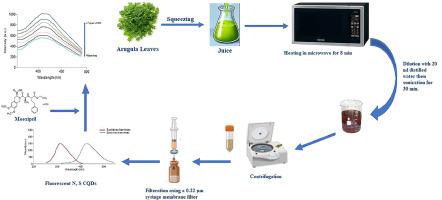Novel and Ultra-sensitive Harnessing of Native Fluorescence and Bio-Inspired N, S-CQDs: A Greener Path to Pharmaceutical and Biological Analysis of Moexipril with Enhanced Sustainability Profiles
IF 3.7
Q1 CHEMISTRY, ANALYTICAL
引用次数: 0
Abstract
Monitoring the level of Moexipril is crucial for hypertensive patients, therefore two environmentally friendly, rapid and selective analytical techniques have been established for its sensitive measurement. First method relies on direct measurement of its native fluorescence at λex 282 nm / λem 315 nm. The second method is based on the efficient and quantitative enhancement of N, S-CQDs fluorescence intensity by Moexipril in the presence of 1% Tween. The remarkably fluorescent N and S-CQDs were developed via 8 minutes microwave-aided one-pot synthesis using promising, cheap and widely available precursors (Arugula leaves) for the first time. The sensor is characterized by excellent doping efficiency (N, 13.01% and S, 12.39%), narrow particle size distribution (2.7±0.6 nm), reproducibility and good fluorescence at λex 320nm / λem 430 nm with 68.5% quantum yield. Also, the designed probe selectivity was verified in presence of possible co-existing excipients, various metal ions and co-administered drugs that grants the practical applicability of N, S-CQDs as an environmental probe. Additionally, both methods showed excellent linearity (r = 0.9999) within the specified concentrations range (0.02-0.6 and 0.004-0.7 µg/mL for method I and II, respectively) and they were implemented for the analysis of Moexipril in pharmaceutical tablets and biological fluids, yielding high recovery percentages. The proposed procedures were fully validated in compliance with the ICH Guidelines. Moreover, the greenness, blueness and whiteness profiles of developed methods were evaluated for accomplishment of a complete ecological profile of the designed fluorimetric methodologies and the excellent obtained results confirmed their excellent eco friendless, good applicability and sustainability.

新型超灵敏的天然荧光和生物激发N, S-CQDs:莫西普利药物和生物分析的绿色途径,具有增强的可持续性特征
莫艾昔普利的监测对高血压患者至关重要,因此建立了两种环境友好、快速、选择性的分析技术,对其进行灵敏的检测。第一种方法依赖于直接测量其在λex 282 nm / λem 315 nm的天然荧光。第二种方法是基于莫艾西普利在1%吐温存在下对N, S-CQDs荧光强度的有效和定量增强。首次以芝麻菜叶为原料,采用8分钟微波辅助一锅法合成了具有显著荧光的N和S-CQDs。该传感器具有良好的掺杂效率(N为13.01%,S为12.39%)、较窄的粒径分布(2.7±0.6 nm)、重复性好、在λex 320nm / λem 430 nm处具有良好的荧光性和68.5%的量子产率。此外,在可能共存的赋形剂、各种金属离子和共同给药的情况下,验证了所设计的探针的选择性,从而使N, S-CQDs作为环境探针具有实际的适用性。方法1和方法2在规定的浓度范围内(方法1为0.02 ~ 0.6µg/mL,方法2为0.004 ~ 0.7µg/mL)均具有良好的线性关系(r = 0.9999),可用于莫艾昔普利片剂和生物液中莫艾昔普利的分析,回收率高。拟议的程序已根据ICH指南进行了充分验证。此外,对所开发方法的绿度、蓝度和白度曲线进行了评价,以完成所设计的荧光法的完整生态剖面,所获得的优异结果证实了其良好的生态友好性、良好的适用性和可持续性。
本文章由计算机程序翻译,如有差异,请以英文原文为准。
求助全文
约1分钟内获得全文
求助全文

 求助内容:
求助内容: 应助结果提醒方式:
应助结果提醒方式:


